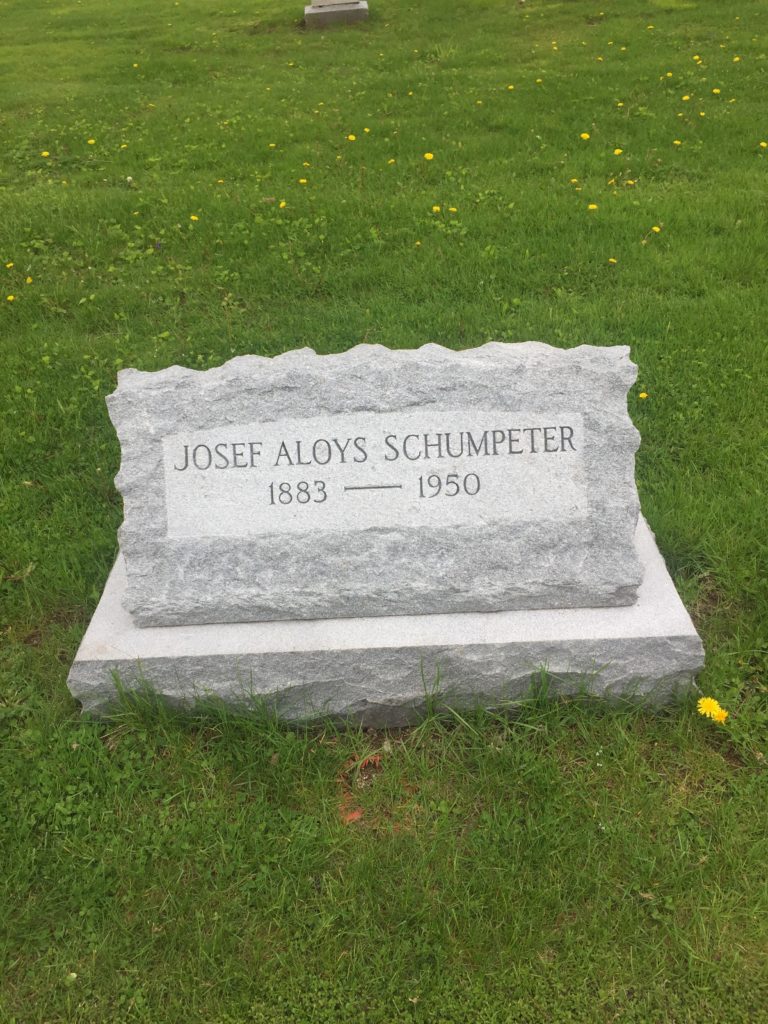Erik Visits an American Grave, Part 973
This is the grave of Josef Schumpeter, though in the U.S., he would routinely spell his name the Anglicized way of Joseph.

Born in what is today the Czech Republic in 1883, Schumpeter always rejected anything to do with the Czechs. He considered himself a German and was proud of it. He grew up in Vienna after his father, a factory owner, died. He was in a rich family and he went to the schools the rich go to. He ended up studying law at the University of Vienna, getting a PhD in 1906, and then taking a job at the University of Czernowitz, in what is today Ukraine. He then went to the University of Graz, back in Austria.
After World War I, Schumpeter was part of the reconstruction effort in Germany. He opposed most of the socialist ideas coming out of the war and worked on ways to pay off the massive debt and reparations the nation faced. He was also involved in banking, but under German law at this time, leading bankers had personal financial responsibility in the banks and this did not work out well for him, leaving him in debt and with a reputation for bad management. He was also Minister of Finance in Austria for a short time, but that didn’t work out either. So in 1925, he went back to academics, working at the University of Bonn. He was a big enough deal that he had sweet visiting deals, including a couple at Harvard and one in Japan.
In 1932, Schumpeter moved to the United States permanently, working at Harvard. There, he was involved in politics, primarily opposing the New Deal. He hated everything that reeked of his despised socialism. He became a U.S. citizen in 1939, but was so opposed to the New Deal and connected enough to Germany that the FBI investigated him for Nazi ties, though they did not find any.
To give Schumpeter credit, unlike most elite academics, he really loved teaching. He was known for teaching far more courses than he had to and being a good performer in the classroom, seeing it as an entertainment project as much as anything else, which is actually a pretty good way to go about teaching. He was seen somewhat skeptically by his colleagues. The field of Economics at this time actually was generally on the good side of the ledger. This was the era of Keynesianism, which Schumpeter definitely did not like. He was operating in pretty significant obscurity in terms of the popular understanding of the field, which at this time like today had its public stars.
That changed in 1942, with the publication of Capitalism, Socialism, and Democracy, which fundamentally argued that the success of capitalism with lead to a corporatism that will therefore lead to intellectuals opposing capitalism and fostering socialism. That socialism will lead into the rise of social democratic parties in the political process and a big welfare state that will then destroy capitalism by oppressing the entrepreneurial class. In short, Schumpeter hated the New Deal, hated what the Democratic Party had become, and thus viewed these changes as undermining capitalism entirely. It was in this book that Schumpeter described what people know him for today–his idea of “creative destruction,” a process by which entrepreneurs destroy older parts of the economy to rejuvenate the entire system. This will often get rid of monopolies that have ground down the economy due to their bigness.
In short, one can see a very clear connection between Schumpeter’s ideas and techbro DISRUPTION today. Schumpeter’s ideas here were very influential with economists and policymakers moved beyond Keyensianism and toward the Chicago School represented by Friedman and the rise of neoliberalism. It was around 2000 when Schumpeter once again gained popularity, as the tech world transformed the economy, as this Times profile from that year suggests.
Schumpeter was happy to now be a star and he wrote for the market. In 1951, he published Ten Great Economists: From Marx to Keynes, for example. Sounds like a real fun book…. Schumpeter died in 1950, of a cerebral hemorrhage while he was asleep. He was 66.
Joseph Schumpeter is buried in Salisbury Cemetery, Salisbury, Connecticut.
If you would like this series to visit other economists, you can donate to cover the required expenses here. Ronald Coase is in Chicago and Irving Fisher is in New Haven. Previous posts in this series are archived here.


